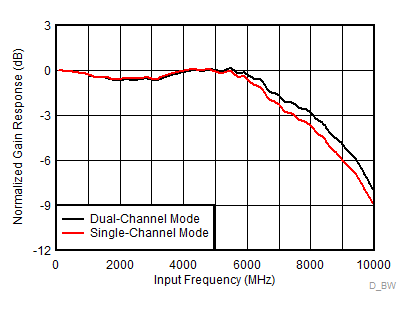JAJSSY9 February 2024 ADC12DL1500 , ADC12DL2500 , ADC12DL500
PRODUCTION DATA
- 1
- 1 特長
- 2 アプリケーション
- 3 概要
- 4 Pin Configuration and Functions
-
5 Specifications
- 5.1 Absolute Maximum Ratings
- 5.2 ESD Ratings
- 5.3 Recommended Operating Conditions
- 5.4 Thermal Information
- 5.5 Electrical Characteristics: DC Specifications
- 5.6 Electrical Characteristics: Power Consumption
- 5.7 Electrical Characteristics: AC Specifications (Dual-Channel Mode)
- 5.8 Electrical Characteristics: AC Specifications (Single-Channel Mode)
- 5.9 Timing Requirements
- 5.10 Switching Characteristics
- 5.11 Timing Diagrams
- 5.12 Typical Characteristics - ADC12DL500
- 5.13 Typical Characteristics - ADC12DL1500 (1GSPS)
- 5.14 Typical Characteristics - ADC12DL1500 (1.5GSPS)
- 5.15 Typical Characteristics - ADC12DL2500 (2GSPS)
- 5.16 Typical Characteristics - ADC12DL2500 (2.5GSPS)
-
6 Detailed Description
- 6.1 Overview
- 6.2 Functional Block Diagram
- 6.3
Feature Description
- 6.3.1 Analog Inputs
- 6.3.2 ADC Core
- 6.3.3 Timestamp
- 6.3.4 Clocking
- 6.3.5 LVDS Digital Interface
- 6.3.6 Alarm Monitoring
- 6.3.7 Temperature Monitoring Diode
- 6.3.8 Analog Reference Voltage
- 6.4
Device Functional Modes
- 6.4.1 Dual-Channel Mode (Non-DES Mode)
- 6.4.2 Internal Dither Modes
- 6.4.3 Single-Channel Mode (DES Mode)
- 6.4.4 LVDS Output Driver Modes
- 6.4.5 LVDS Output Modes
- 6.4.6 Power-Down Modes
- 6.4.7 Calibration Modes and Trimming
- 6.4.8 Offset Calibration
- 6.4.9 Trimming
- 6.5 Programming
- 7 Application and Implementation
- 8 Register Maps
- 9 Device and Documentation Support
- 10Revision History
- 11Mechanical, Packaging, and Orderable Information
3 概要
ADC12DL500、ADC12DL1500、ADC12DL2500 は A/D コンバータ (ADC) のファミリで、デュアル チャネル モードで最大 500MSPS、1.5GSPS、2.5GSPS、シングル チャネル モードで最大 1GSPS、3GSPS、5GSPS をサンプリングできます。チャネル数 (デュアル チャネル モード) とサンプル レート (シングル チャネル モード) のトレードオフをプログラム可能なため、多くのチャネル数や広い瞬間的な信号帯域幅アプリケーションの両方の要求に対応する、柔軟なハードウェアを開発できます。
これらのデバイスはレイテンシが短い低電圧差動信号 (LVDS) インターフェイスを使用しており、レイテンシが重要なアプリケーションや、LVDS の単純性が好ましい場合に適しています。インターフェイスは最大48のデータ ペア、4つのダブル データ レート(DDR)クロック、および4つのストローブ信号を使用して、4つの12ビット データ バスに編成されます。このインターフェイスは、最高 1.6Gbps の信号速度をサポートします。ストローブ信号により、バス間や複数のデバイス間の同期が簡単になります。このストローブは内部的に生成され、SYSREF 入力により決定論的なタイミングでリセット可能です。ノイズなしのアパーチャ遅延 (TAD) 調整や SYSREF のウィンドウ処理などの革新的な同期機能により、複数デバイスの同期がさらに簡単に行えます。
 ADC12DLx500 の周波数応答
ADC12DLx500 の周波数応答